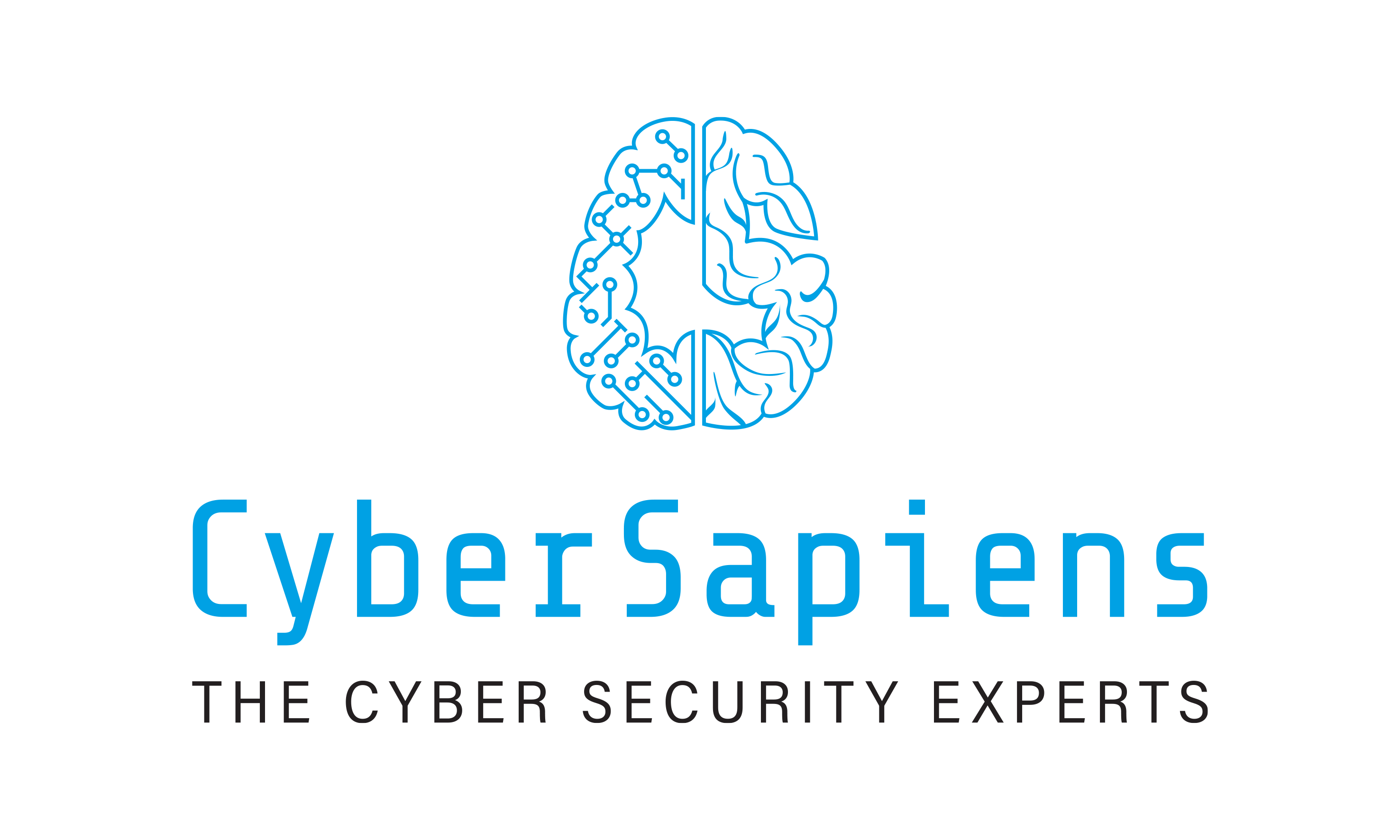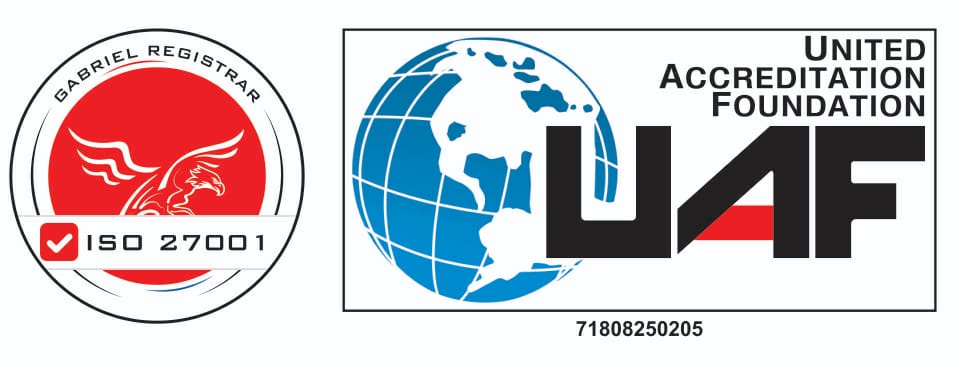cybersecurity is no longer a luxury, but a necessity for businesses in Canada. With the rise of sophisticated cyber threats, companies of all sizes are recognizing the importance of having robust security measures in place to protect their sensitive data and prevent potential breaches. One effective way to achieve this is by implementing Security Operations Center (SOC) services.
In this article, we will explore the Top 15 Reasons Why Security Operations Center Services are Important for Businesses in Canada.
List of Top 15 Reasons Why Security Operations Center Services are Important for Businesses in Canada

Here is the list of the Top 15 Reasons Why Security Operations Center Services are Important for Businesses in Canada.
1. 24/7 Monitoring and Threat Detection
SOC services provide around-the-clock monitoring of a company’s network and systems, allowing for swift detection and response to potential threats. This proactive approach helps prevent breaches and minimizes the risk of data loss or reputational damage.
2. Advanced Threat Protection
SOC services utilize cutting-edge threat intelligence to detect and analyze even the most complex and evasive threats, such as zero-day attacks and advanced persistent threats (APTs). This advanced protection is essential for businesses in Canada, where the threat landscape is constantly evolving.
3. Incident Response and Containment
In the event of a security breach, SOC services provide quick and effective incident response and containment, minimizing the damage and reducing the risk of further attacks. This rapid response helps to mitigate the impact of a breach on the business, customers, and partners.
4. Compliance with Regulatory Requirements
Canadian businesses must comply with various regulatory requirements, such as the Personal Information Protection and Electronic Documents Act (PIPEDA) and the General Data Protection Regulation (GDPR). SOC services help businesses meet these requirements by providing a comprehensive security framework that includes monitoring, threat detection, and incident response.
5. Reduced Risk of Ransomware Attacks
Ransomware attacks are a significant threat to businesses in Canada, with many companies having been affected in recent years. SOC services provide an additional layer of protection against ransomware attacks, helping to prevent data loss and minimize downtime.

6. Improved Network Visibility
SOC services provide real-time visibility into a company’s network and systems, allowing security teams to detect and respond to potential threats more effectively. This enhanced visibility also enables businesses to optimize their network performance and improve overall security posture.
7. Cost Savings
Implementing a SOC can help businesses in Canada reduce costs associated with security breaches, including the cost of incident response, data loss, and reputational damage. SOC services can also help companies avoid costly security investments by identifying and prioritizing security gaps.
8. Enhanced Security Posture
SOC services help businesses in Canada improve their overall security posture by providing a comprehensive security framework that includes threat detection, incident response, and vulnerability management.
9. Reduced False Positives
SOC services are designed to reduce false positives, which can quickly overwhelm security teams and lead to alert fatigue. By utilizing machine learning and analytics, SOC services can help prioritize and filter out false positives, ensuring that security teams can focus on real threats.
10. Scalability and Flexibility
SOC services are designed to scale with the needs of growing businesses, providing flexibility and adaptability in response to changing security requirements.
11. Third-Party Risk Management
Many businesses in Canada rely on third-party vendors and suppliers, which can introduce security risks if not managed properly. SOC services can help companies assess and mitigate third-party risks, ensuring that data and systems remain secure.

12. Insider Threat Detection
Insider threats are a significant concern for businesses in Canada, with many breaches caused by privileged access or unauthorized data access. SOC services can help companies detect and respond to insider threats, protecting sensitive data and preventing potential breaches.
13. Cloud Security
As more businesses in Canada move to the cloud, security measures must adapt to protect data and applications. SOC services provide cloud security expertise, helping companies to securely adopt cloud technologies and ensure data protection.
14. Threat Intelligence
SOC services leverage threat intelligence to stay ahead of emerging threats and vulnerabilities, providing actionable insights to security teams and enabling proactive defence.
15. Continuous Monitoring and Improvement
SOC services are designed to continuously monitor and improve a company’s security posture, helping businesses in Canada stay ahead of the evolving threat landscape and achieve long-term security success.
Top 5 Recommendations for Implementing SOC Services
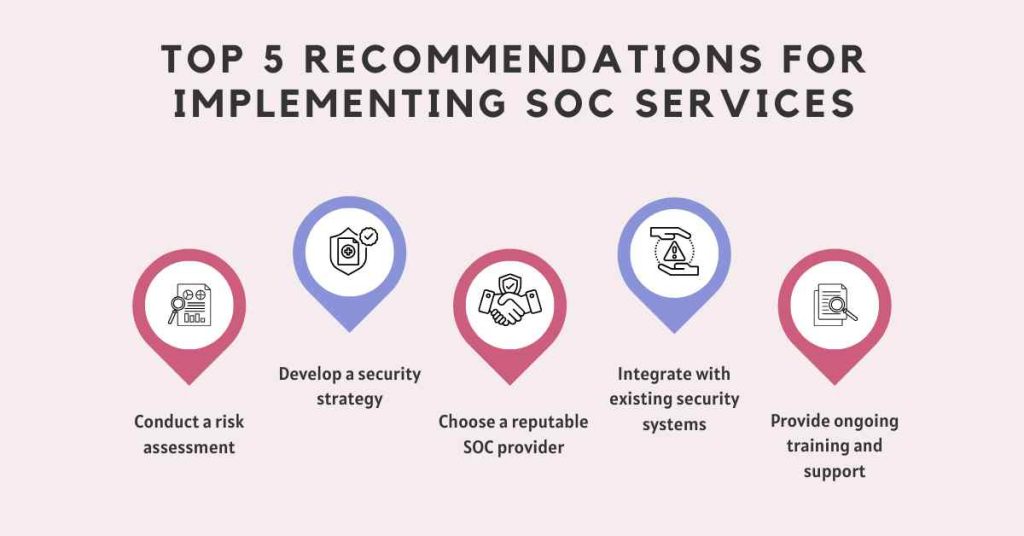
For businesses in Canada looking to implement SOC services, we recommend the following:
1. Conduct a risk assessment
Evaluate your company’s security posture and identify potential vulnerabilities.
2. Develop a security strategy
Create a comprehensive security strategy that includes SOC services and aligns with business objectives.
3. Choose a reputable SOC provider
Select a provider with expertise in threat detection, incident response, and security analytics.
4. Integrate with existing security systems
Ensure seamless integration with existing security systems and tools.
5. Provide ongoing training and support
Ensure security teams receive regular training and support to maximize the benefits of SOC services.
Top 5 Best Practices for SOC Operation
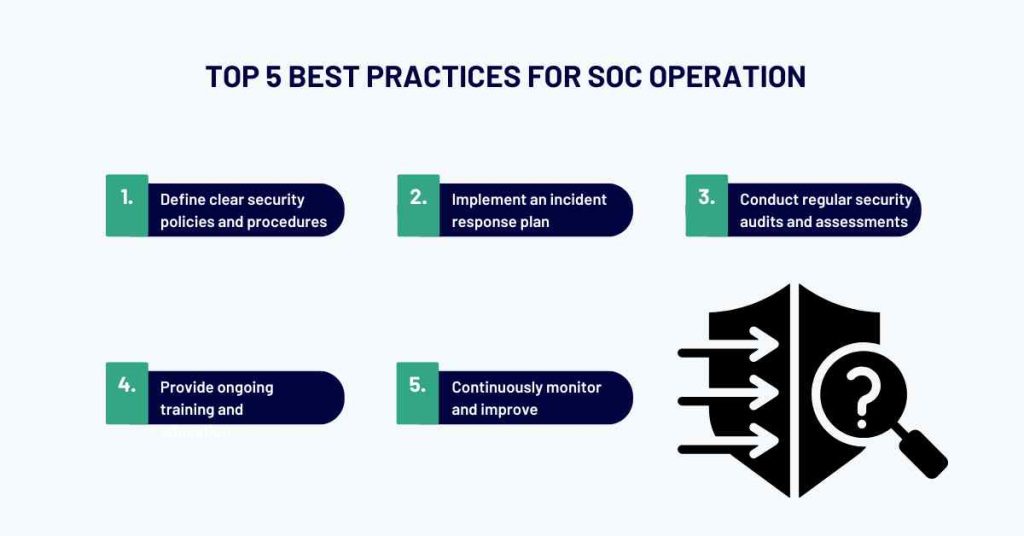
To ensure effective SOC operation, we recommend the following best practices:
1. Define clear security policies and procedures
Establish clear security policies and procedures that outline the roles and responsibilities of the SOC team.
2. Implement an incident response plan
Develop a comprehensive incident response plan that outlines the procedures for responding to security incidents.
3. Conduct regular security audits and assessments
Conduct regular security audits and assessments to identify and mitigate potential security risks.
4. Provide ongoing training and education
Provide ongoing training and education to the SOC team to ensure they stay up-to-date with the latest security threats and technologies.
5. Continuously monitor and improve
Continuously monitor and improve the SOC’s performance, making adjustments as needed to ensure optimal security posture.
Top 4 Benefits of Outsourcing SOC Services
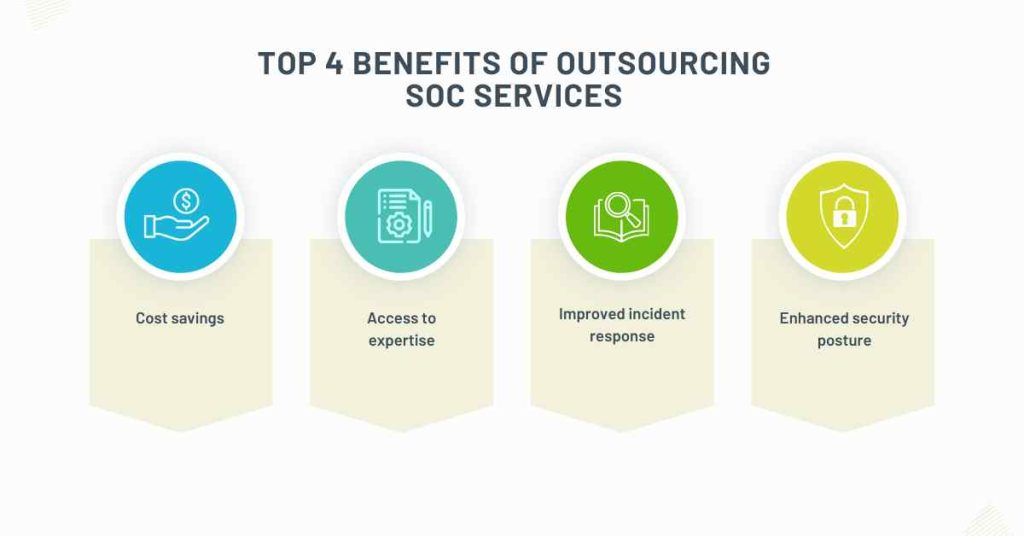
Outsourcing SOC services can provide numerous benefits, including:
1. Cost savings
Outsourcing SOC services can help businesses in Canada reduce costs associated with security breaches and security investments.
2. Access to expertise
Outsourcing SOC services provides access to expert security professionals with the latest knowledge and skills.
3. Improved incident response
Outsourcing SOC services can help businesses in Canada improve their incident response capabilities, minimizing the damage and risk of further attacks.
4. Enhanced security posture
Outsourcing SOC services can help businesses in Canada enhance their overall security posture, protecting their sensitive data and preventing potential breaches.
Summary
Here is the summary for the blog title Top 15 Reasons Why Security Operations Center Services are Important for Businesses in Canada:
- 24/7 Monitoring and Threat Detection
- Advanced Threat Protection
- Incident Response and Containment
- Compliance with Regulatory Requirements
- Reduced Risk of Ransomware Attacks
- Improved Network Visibility
- Cost Savings
- Enhanced Security Posture
- Reduced False Positives
- Scalability and Flexibility
- Third-Party Risk Management
- Insider Threat Detection
- Cloud Security
- Threat Intelligence
- Continuous Monitoring and Improvement
Conclusion
In conclusion, Security Operations Center (SOC) services are essential for businesses in Canada, providing a proactive approach to cybersecurity and helping companies mitigate the risk of breaches, data loss, and reputational damage.
By implementing a SOC, businesses can ensure compliance with regulatory requirements, reduce the risk of ransomware attacks, and improve their overall security posture.
With the threat landscape constantly evolving, SOC services provide a vital layer of protection for businesses in Canada, enabling them to thrive in a secure and ever-changing digital world.
FAQs: Top 15 Reasons Why Security Operations Center Services are Important for Businesses in Canada
1. What is the primary goal of a Security Operations Center (SOC)?
Ans: The primary goal of a Security Operations Center (SOC) is to monitor and manage an organization’s security posture 24/7 to identify, detect, and respond to potential security threats and vulnerabilities.
2. How does a SOC help organizations improve their incident response capabilities?
Ans: A SOC helps organizations improve their incident response capabilities by providing a centralized unit that is responsible for monitoring and managing security incidents, detecting and responding to potential threats, and providing incident response planning and training to security teams.
3. What types of security tools and technologies are typically used in a SOC?
Ans: A SOC typically uses a variety of security tools and technologies, including Security Information and Event Management (SIEM) systems, Intrusion Detection Systems (IDS), Intrusion Prevention Systems (IPS), Network Monitoring Systems (NMS), and Security Orchestration, Automation, and Response (SOAR) tools.
4. Can a SOC be used in a cloud-based environment?
Ans: Yes, a SOC can be used in a cloud-based environment. In fact, many organizations are moving their security operations to the cloud to take advantage of the scalability and flexibility that cloud-based security solutions offer.
5. How does a SOC ensure that security incidents are properly documented and reported?
Ans: A SOC ensures that security incidents are properly documented and reported by maintaining a comprehensive incident response plan, conducting regular security audits and assessments, and providing training to security teams on incident response and reporting procedures.
6. What are some common challenges that organizations face when implementing a SOC?
Ans: Some common challenges that organizations face when implementing a SOC include the cost and complexity of implementing and maintaining a SOC, the need for specialized skills and expertise, and the challenge of integrating a SOC with existing security systems and tools.
7. How does a SOC help organizations meet regulatory requirements and compliance standards?
Ans: A SOC helps organizations meet regulatory requirements and compliance standards by providing a centralized unit that is responsible for monitoring and managing security incidents, detecting and responding to potential threats, and providing incident response planning and training to security teams.
8. What is the role of threat intelligence in a SOC?
Ans: Threat intelligence plays a critical role in a SOC by providing real-time information about potential security threats and vulnerabilities, enabling security teams to detect and respond to threats more effectively.
9. Can a SOC be used in a small or medium-sized business (SMB) environment?
Ans: Yes, a SOC can be used in a small or medium-sized business (SMB) environment. While SMBs may not have the same level of resources as larger organizations, they can still benefit from the use of a SOC to help manage and mitigate security risks.
10. How does a SOC help organizations measure and report on security performance?
Ans: A SOC helps organizations measure and report on security performance by providing a centralized unit that is responsible for monitoring and managing security incidents, detecting and responding to potential threats, and providing incident response planning and training to security teams. This enables organizations to measure and report on key security performance indicators (KPIs) such as incident response times, threat detection rates, and security incident frequency.

